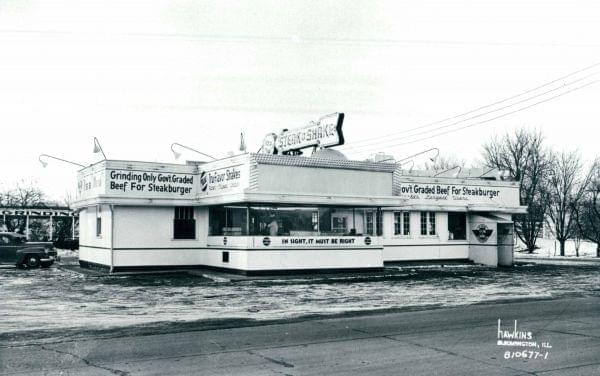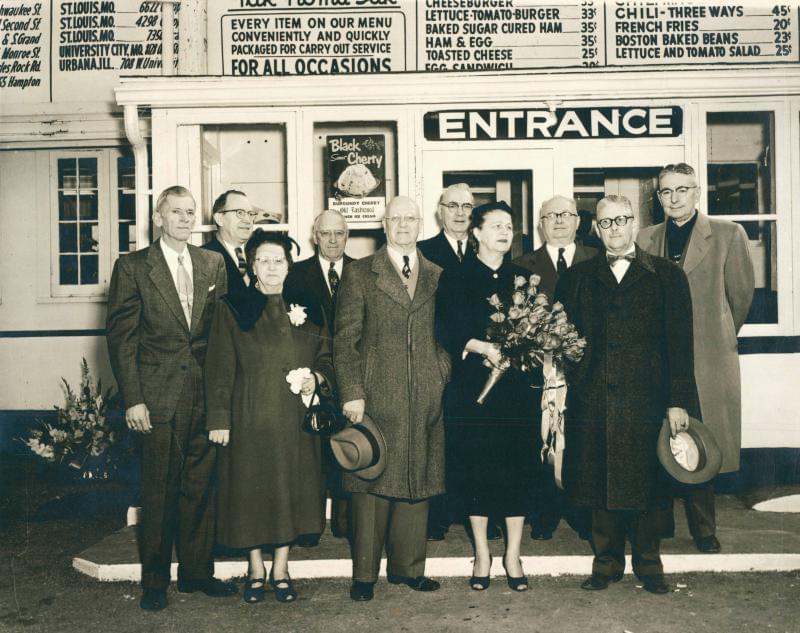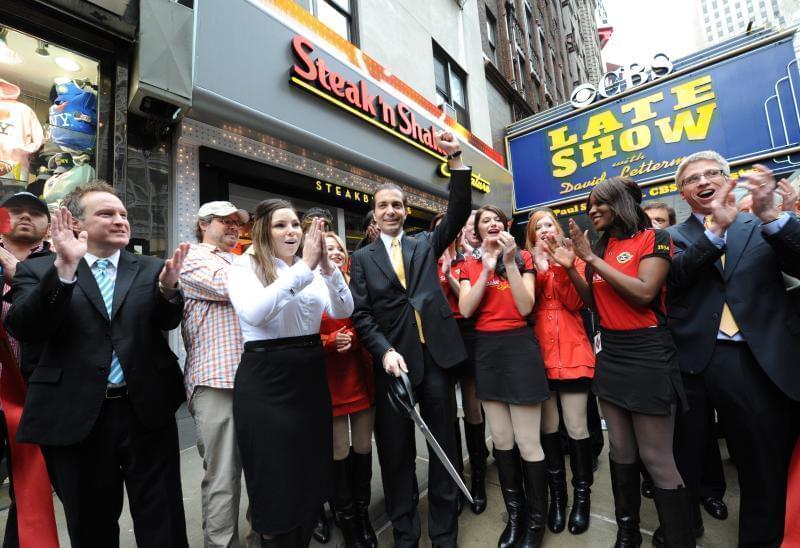85 Years After Founding In Normal, Challenges Put Steak ‘n Shake On The Brink

Gus and Edith Belt opened the first location at Main Street and Virginia Avenue in Normal in 1934. Their family sold the company in 1969. McLean County Museum of History
Greg Snodgrass started at Steak ’n Shake as a bus boy in 1979 in Bloomington-Normal.
His career grew as the company did. He and other local staff would travel the country to help open new locations and train staff on the Steak ’n Shake culture: quality service and cleanliness. They had pre-shift meetings for uniform inspections. It was fun, Snodgrass said.
By 2008, it wasn’t fun anymore. Snodgrass was a district manager then, overseeing nine locations between Bloomington and Paducah, Ky. The new owner, Biglari Holdings, was cutting wages and benefits, Snodgrass said, part of a recession-era discounting survival plan. So Snodgrass left.
Today, those changes have brought Steak ’n Shake to the brink. Sales have sunk, around 100 locations have closed, employee lawsuits have piled up, and some are speculating that a major contraction—or worse—is near.
“It’s heartbreaking, quite honestly,” said Snodgrass, who now works for another restaurant chain. “I dedicated over 30 years of my career to help build that company and build relationships. When you walk into a restaurant today, the service isn’t good, and the cleanliness isn’t there. The quality of the food is still there, but without the other two things, it really isn’t Steak ’n Shake anymore.”

Edith Belt (with flowers) at a 20th anniversary event for Steak n Shake in Normal.
Local History
Steak ’n Shake is one of Bloomington-Normal’s most famous exports, right up there with State Farm and Beer Nuts. Gus and Edith Belt opened the first location at Main Street and Virginia Avenue in Normal in 1934. Their family sold the company in 1969 and it’s changed hands many times since then. Today, Steak ’n Shake is based in Indianapolis and owned by Texas-based Biglari Holdings. It has 580 locations, including four in Bloomington-Normal. (The original site is now a Monical’s.)
A few other locally grown companies followed a similar path, notably Eureka-Williams, which became Electrolux and later moved away.
“Bloomington-Normal, given its vibrancy over its history, has produced corporations and brand names that are known throughout the country and sometimes throughout the world. Some of those still have local ties, and some do not,” said Bill Kemp, librarian at the McLean County Museum of History.
Gus and Edith Belt built Steak ’n Shake’s brand on the promise of cleanliness—not too common for hamburger joints back then—and steakburgers, Kemp said. An early company slogan was “In Sight, It Must Be Right.”
“That seems a little antiquated now, but the idea was, if you could see the food being made—the grill cooks were out in the open through glass windows, and the meat was ground on site—that was an indication that things were on the up and up there,” Kemp said.
Who is Biglari?
Sardar Biglari, a young investor who emigrated to the U.S. from Iran, took over Steak ’n Shake in 2008, amid the Great Recession. He discounted relentlessly—famously offering meals under $4—and sales soared.
“For seven years, he seemingly could do no wrong,” said Greg Andrews, who’s covered the company extensively as editor of the Indianapolis Business Journal. “That worked and worked and worked. And then about 2016, it’s stopped working. The company has continued to really slide since then.”
Critics say the customer experience slipped, and so did the service. All that discounting comes at a cost.
Steak ’n Shake also faced a new challenge from growing fast casual chains, such as Chipotle, Panera, and Jason’s Deli. Younger consumers were willing to pay more, and the race to the bottom for value was ending, said Danny Klein, who covers Steak ’n Shake for the QSR food trade magazine.
“So you’re either playing on one side, of convenience, or you’re going higher-end like a fast casual,” Klein said. “So Steak ’n Shake, they’re not really offering either of those.”
Biglari is a mysterious figure who famously does not do media interviews. His only public comments typically come in his annual shareholder letters.
“Despite our unwavering dedication to product quality and low prices, we erroneously stayed with equipment and kitchen design that was ill-suited for volume production,” Biglari wrote in his 2019 letter. “The effect has been high-cost, labor-intensive slow service. We failed customers by not being fast and friendly.”
They’ve paid the price. Steak ‘n Shake’s revenue last year declined 3.4%, what Biglari himself called a “significant disappointment” in the 2019 letter to shareholders. During the first quarter of 2019, same-store sales fell 7.9%—the 10th straight quarterly decline—even as other similar restaurants saw growth.
“They’re playing smack dab in a very competitive set, from big national players with huge reach and big marketing dollars, all the way down to regional and independent burger places,” said David Henkes, advisory group senior principal at Technomic, a research and consulting firm for the restaurant industry.
“They’re a larger chain, in a slower-than-average growth category (burgers), where they’re not doing much to differentiate themselves,” Henkes added. “Not that it’s a death knell for the chain, but it’s certainly a challenge for them to grow out of that without doing something different.”

Sardar Biglari, center, chairman and CEO of Steak n Shake, celebrates the opening of New York's first Steak n Shake Signature concept restaurant in Midtown Manhattan in 2012.
Franchise Partner Program
“Something different” is an ambitious franchising strategy that Biglari laid out earlier this year.
Biglari wants to franchise off all 400+ company-owned restaurants. Franchisees will only have to put up $10,000—a bargain in the industry—and will pay 15% of sales and 50% of profits back to Steak ‘n Shake. And franchisees can only own one restaurant, similar to the Chick-fil-A model geared toward hands-on franchise ownership.
Tom Murray, chief financial officer for Steak 'n Shake franchise operations, said there have been "thousands" of inquiries since the franchise partner program was announced. But he declined to say how many franchise partners have been finalized. "There are a lot in the pipeline," Murray said.
"We feel very confident we're taking the operations of the business to another level through the franchise partner program. And it's exciting because we're giving people with the ability to own their own business, but not necessarily the financial wherewithal, we're giving them the opportunity to live the American dream," Murray said.
Retroactively turning a restaurant chain into an all-franchise model is unusual, experts told GLT. To prepare, Steak ‘n Shake has temporarily closed around 100 locations, Murray said, including including in Peoria. Most are expected to reopen under franchise ownership, he said. Others will reopen as pilot concept restaurants for Steak 'n Shake. One closed unit in Indiana has been converted into a "Steak 'n Shake 2.Go" drive-through concept that's takeout only, Murray said.
"Drive-through has become a significant portion of our business," he said. "That's really the trend."
Alok Shivpuri was the first franchise partner, taking over a single previously underperforming location in Rockwell, Texas, near Dallas. He said he never couldn't have raised the $2 million necessary to franchise a traditional restaurant himself. The $10,000 price point made it workable, Shivpuri said.
"It's about putting the sweat equity in, and not money," he said.
Shivpuri said his employees are happier—and making more money themselves.
"They're not working for a corporation anymore. They're working with me," he said. "I know my team's needs and my community's needs."
Others are skeptical about the plan. Generally when a chain restaurant “temporarily” closes, it tends not to reopen, Klein said.
“I haven’t seen anybody offer up a franchise for $10,000. It’s definitely very, very uncommon,” Klein said. “Everything they’re doing right now is pretty uncommon.”
Costly Lawsuits
Steak ‘n Shake also faces a big challenge in court.
Nearly 1,500 Steak ‘n Shake managers across the country have sued the company, claiming they were improperly classified as salaried employees and not compensated for the overtime they worked. Around 286 managers from the St. Louis area were just awarded $7.7 million in the first of two lawsuits. The second pending lawsuit has just under 1,200 plaintiffs, including around 400 from Illinois, said their attorney, Brendan Donelon of Kansas City, Mo.
These managers were only making $32,000 to $40,000 a year and were doing much of the same work as lower-level hourly employees, Donelon said.
“Their job was to plug in the holes each and every shift. It’s pretty easy to figure out that, if you’re not having to pay the hourly people overtime to do all this work, and you’re paying one person just a set dollar amount to work 70 hours a week, it’s a big cost-cutting and savings measure for a company,” he said.
Steak ‘n Shake said each case is “without merit” and that it “intends to defend these cases vigorously.” However, the company is set for settlement talks with plaintiffs from both cases in early June, Donelon said.
Does all this add up to the end for Steak ‘n Shake?
Andrews, who covers the company from Indianapolis, said Steak ‘n Shake “has about $184 million in debt that it’s supposed to pay off in March 2021. And it’s losing a lot of money at the moment.”
“If it starts to turn itself around, then lenders will probably give it some more breathing room. But if it’s in a tailspin—which is what it’s in today—that debt could force Steak ‘n Shake into bankruptcy.”
A significant retraction—fewer locations—may be more likely. It’s not uncommon today to see restaurant chains retract pretty dramatically, Klein said. Applebee’s is one recent example.
“A chain of this scale and with this much guest affinity and history, and the fact they were on a pretty good run there for a while, I’d be surprised if they went bankrupt. But nothing is impossible in this industry,” he said.
Donelon, the attorney who represents the managers, said it’s “hard to speculate” about the company’s financial health because Steak ‘n Shake is just one part of the Biglari Holdings portfolio. Biglari also owns Maxim magazine and Western Sizzlin restaurant chain, among other investments.
“It’s always a concern when you’ve got claims like this, that something might go wrong with the company and they might not be able to fulfill their obligation to pay what the jury says they should pay,” he said.
Snodgrass, the bus boy who became a district manager, gave the company another chance himself. He returned from 2010 to 2013. But it wasn’t enjoyable anymore. The family-friendly atmosphere was gone. He left again.
“There’s some talk they might just fold up and go away. I hope that doesn’t happen,” Snodgrass said.

